|
Size: 4061
Comment: Changed Penguin model, formatting on Shaun's notes.
|
Size: 7656
Comment:
|
| Deletions are marked like this. | Additions are marked like this. |
| Line 1: | Line 1: |
| This page collects information on the hardware we plan to install at a colocation provider as part of our new hosting infrastructure. Some older discussion and similar stuff is on NewSystemHardwareArchive. | #pragma section-numbers off |
| Line 3: | Line 3: |
| = System setup = Currently, what we know are the uses for the three machines we will base our infrastructure on. We also know our Abulafia machine configuration, and Justin Leitgeb's to-be-donated server configuration. What we need to come up with, is the ideal setup for the third machine that we will have to buy. So, the machine configurations and intended uses follow: |
This page collects information on the hardware that we have installed or plan to install as part of HCoop infrastructure. |
| Line 6: | Line 5: |
| == Justin Leitgeb's donation: Dell PowerEdge 2850 == * Processor: 2 x 2.8 GHz * RAM: 4 GB * Disks: |
<<TableOfContents>> = Peer1 = Current pictures of the actual Peer1 cabinet are at [[http://hcoop.net/~rkd/hcoop/imgs/]], taken during [[http://wiki.hcoop.net/OnSiteVisits/20090821]]. == deleuze == * Location: Peer1 * Model: Dell PowerEdge 2850 * Processor: 2 x 2.8 GHz Intel Xeon (2/2) * RAM: 4 GB (? slots, 16 GB Max, DDR-2400 SDRAM) * Disks (controller Ultra 320 SCSI): |
| Line 12: | Line 20: |
| * LAN: 2 x 10/100/1000 | |
| Line 13: | Line 22: |
| '''Intended use: fileserver and host for all services that don't involve dynamic content provided by non-admins. No user logins.''' | * Form factor: 2U * OS: Debian stable * User logins: no * Source: donation by Justin Leitgeb |
| Line 15: | Line 27: |
| == HCoop's currently-underused machine Abulafia == | * [[https://dcse.dell.com/selfstudy/Associates_7_0/Enterprise/PowerEdge/PE2850/printer_friendly.asp|Maintenance Manual for the PE 2850]] * http://www.dell.com/downloads/global/products/pedge/en/2850_specs.pdf * {{http://hcoop.net/~docelic/dell-poweredge-2850-i1.jpg}} * (note: picture above not accurate) * Real picture:{{http://hcoop.net/~docelic/deleuze.hcoop.net.jpg}} '''Use: fileserver, database server, email server, host for all services that don't involve dynamic content provided by non-admins.''' == mire == * Location: Peer1 * Model: Sun Fire v20z * Processor: 1 x 1.6GHz AMD64 (Opteron) (1/2) * RAM: 5 GB (initial 2x512MB and additional 2x2GB, ? slots, 16 GB Max, DDR1/333 or DDR1/400 SDRAM) * Disks (controller Ultra 320 SCSI): * 2 x 36 GB (hot swap) * CD-Rom * Floppy * LAN: 2 x 10/100/1000 * Form factor: 1U * Ports: 1 x USB 1.1, 1 x DB9 serial, 2 x PCI-X * Power: 100-240 V, 50/60 Hz, 465 W PFC supply, dual redundant fans * Dimensions: W 16.94 in / H 1.69 in / D 28.5 in / Weight 35 lbs * OS: Debian stable * User logins: yes * Source: donated by Ray Racine * [[RebootingMireSp]] * [[http://docs.sun.com/source/817-5248-21/|SunFire v20z User Guide]] * [[http://docs.sun.com/source/817-5249-17/|Service Processor Manual]] * http://docs.sun.com/source/817-5248-20/index.html * http://www.sun.com/servers/entry/v20z/index.jsp * {{http://hcoop.net/~docelic/sunFIRE_V20z.jpg}} * {{http://www.sun.com/servers/entry/v20z/images/gallery/full/img_3.jpg}} * {{http://hcoop.net/~docelic/SunFireV20z_expl.gif}} * Real picture:{{http://hcoop.net/~docelic/mire.hcoop.net.jpg}} '''Use: dynamic web content, services that involve running arbitrary code from members (including custom daemons, etc.)''' == kvm == * Location: Peer1 * Model: StarTech IP KVM * Source: Newegg? * [[KvmAccess]] * [[http://www.startech.com/Data/ProductManuals/SV1110IPEXT.pdf?c=US|StarTech manual]] ([[http://hcoop.net/~docelic/SV1110IPEXT.pdf|local copy]]). The StarTech Server Remote Control External KVM over IP provides access to systems that may have a degraded network. It allows us to monitor Power-On Self Test (POST), configure BIOS/CMOS, and even reinstall operating system software. It must be connected to another multiple port KVM in order to have access to more than one server. = Tech.coop = == outpost == * Location: Tech.Coop (hosted at Bytemark, UK) * Model: Xen VM * Processor: * RAM: 512 MB * Disk: 40 GB RAID * OS: Debian stable * User logins: no '''Use: secondary DNS on a different subnet, all tasks requiring remote location.''' == hopper == * Location: Peer1 * Model: IBM xSeries 335 * Processor: 2 x P4 XEON 2.6Ghz * RAM: 4 GB, 2x1 GB, 1x2 GB (3/4 slots, 8 GB Max, PC2100 ECC registered) * Disks: * 2x SCSI Ultra 320 80 pin. SEAGATE - 5 YEARS MFG WARRANTY. CHEETAH 73.4GB 15000 RPM 80PIN ULTRA320 SCSI HARD DISK DRIVE. 16MB BUFFER 3.5 LOW PROFILE(1.0 INCH). ST373455LC * Floppy 3.5" * LAN: 2 x 10/100/1000 * Ports: 3 x USB, 1 x serial, 2 x PCI-X * PSU: 1/1 * Form factor: 1U * Dimensions: W 17.5 in / H 1.75 in / D 25.75 in / Weight 33 lbs * OS: * User logins: no * Name voting at https://members.hcoop.net/portal/poll?report=17 * Source: US Ebay, seller lapkosoft. http://cgi.ebay.com/ws/eBayISAPI.dll?ViewItem&item=300200776299 * Real picture:{{http://hcoop.net/~docelic/hopper.hcoop.net.jpg}} * [[HopperServiceProcessor]] * {{http://hcoop.net/~docelic/IBM_xSeries335_Front_0Bay.jpg}} [[attachment:Back of hopper, taken 24feb09.jpg]] [[attachment:Hopper card closeup, taken 24feb09.jpg]] [[attachment:Inside hopper, taken 24feb09.jpg]] '''Use: Initially, server was set up by Clinton Ebadi. It's purpose is to serve as a secondary KDC/AFS server instead of Krunk, and an email server (all email processing).''' (The 1x2 GB RAM module was acquired from Newegg, and the two disks from ServerSupply. Purchases were made in Sep 2008, but ServerSupply took good 3 weeks to deliver). = Awaiting setup = None. = Awaiting purchase = None. = Decommissioned = == abulafia: shell server == |
| Line 20: | Line 140: |
| '''Intended use: refurbished slightly to serve as a generic shell server and the only machine where usage not strictly related to "Internet hosting" is permitted.''' | '''Intended use: refurbished slightly to serve as a generic shell server and the only machine where usage not strictly related to "Internet hosting" is permitted. Due to failing parts the machine was decomissioned completely and is no longer planned for reuse.''' |
| Line 22: | Line 142: |
| == New server, for which we need to come up with hardware specifications == * Processor: Single AMD 275 (Dual-core) * RAM: 4 GB RAM (2 x 2 GB) * Disks: 2 x 120 GB SATA * Penguin Model: Altus 1300 * List price: $3163.00 * Extra: Should be 1U. Goal is to make it processor intensive, and only disk-heavy enough to ensure a high level of uptime. Other considerations such as a preference for AMD and the vendor Penguin Computing that have been expressed on the list and in meetings should be followed here. More information from online configuration: [http://www.hcoop.net/~leitgebj/hcoop_servers/altus_1300_20060606.pdf (PDF)] [http://www.hcoop.net/~leitgebj/hcoop_servers/altus_1300_20060606.ps (PS)] '''Intended use: dynamic web content and any other Internet services that involve running arbitrary code from members (including custom daemons, etc.)''' == Switch == We are proceeding under the assumption that we'll use ShaunEmpie's donation (see HardwareDonations), a Nortel (Baystack) 380 switch. He says: It is not brand new but is working. Here is [http://vpit.net/es380-guide.pdf a guide] that I was able to find to give anyone interested a more in depth view of it. VLAN Configuration Proposal: {{{ With our new setup, I think it would be best to setup a few different VLANs for different uses. For anyone who is unfamiliar with the term, a VLAN is a virtual lan. It allows you to have completely separate networks on the same switch. This will allow us to setup a private network that the public and peer1 would have no access to. This could be handy for database systems, NAS, backup servers, etc which you'd want to keep off the public network. Proposed Configuration: VLAN 1. Management VLAN - not used for normal traffic VLAN 10. Public VLAN - public/Peer1's network VLAN 20. Private VLAN - private subnet for inter-server traffic For a starting point i think having ports 1-12 in VLAN 10 and ports 13-24 in VLAN 20 would be best. The VLAN membership of a port can be changed easily so these would not be set in stone. The switch allows for many more VLANs than we'll ever need so if anyone has a suggestion or need for another VLAN it would be trivial to setup. Any questions/comments, let me know. -Shaun}}} ES380 AC Power Specs: |
== baltar == * Location: Peer1 * Nortel Baystack 380 switch * Fabric: Dual 24-port Gigabit * Memory: 16 MB SDRAM, 32 MB Flash |
| Line 72: | Line 151: |
| * Dimensions: W 17.25 in / H 2.77 in / D 12.75 in / Weight 10.60 lbs * Source: donation by ShaunEmpie * http://support.nortel.com/go/main.jsp?cscat=DOCUMENTATION&poid=11941 * [[http://hcoop.net/~docelic/214390a.pdf|214390a.pdf]], [[http://hcoop.net/~docelic/214391a.pdf|214391a.pdf]], [[http://hcoop.net/~docelic/214392a.pdf|214392a.pdf]], [[http://hcoop.net/~docelic/214393a.pdf|214393a.pdf]], [[http://hcoop.net/~docelic/214394a.pdf|214394a.pdf]], [[http://hcoop.net/~docelic/216339a.pdf|216339a.pdf]] * {{http://hcoop.net/~docelic/baystack380gbit.jpg}} * Our switch "Baltar" was replaced by a smaller version in Dec 2008 to free up cabinet space, both for extra airflow and preparation to rack a new machine, to which all email processing will be moved. |
|
| Line 73: | Line 158: |
| == Serial console == | == xanadu == |
| Line 75: | Line 160: |
| Some device to simulate local login over the Internet could be a life saver. JustinLeitgeb mentions a special card that Dell sells that would work with his donation. | * Location: ??? * Model: Dell PowerEdge 1650 * Processor: Dual P3 1.4GHz (2/2) * RAM: 2 GB (?/4 slots, 4 GB Max, 72-bit ECC PC-133 SDRAM ) * Disks (controller Ultra 160 SCSI): * 1 x 18 GB (1/3) * Floppy 3.5" * LAN: 2 x 10/100/1000 * Ports: 2 x PCI-X * PSU: ?/2 * Power: 100–240 VAC, 50/60 Hz, 3.9–2.0 A, 275 W (AC) per PSU * Form factor: 1U * Dimensions: W 19 in / H 1.67 in / D 26.9 in / Weight 35 lbs * OS: * User logins: * Source: donation by NathanKennedy * http://support.dell.com/support/edocs/systems/pe1650/en/index.htm * {{http://hcoop.net/~docelic/servidoresdell1650.jpg}} '''Use: ''' == krunk == * Location: Peer1 * Model: Sun Netra * Processor: * RAM: * Disks: * 2 x 200GB Unknown RPM and Manufacturer * Form factor: 1U? * OS: Debian stable? * User logins: no * Source: donation by Adam Megacz * KrunkInfoz * Real picture: {{http://hcoop.net/~docelic/krunk.hcoop.net.jpg}} '''Use: was a secondary KDC and AFS server. Decomissioned after it developed problems in the hardware (as we perceived it) network stack. ''' |
This page collects information on the hardware that we have installed or plan to install as part of HCoop infrastructure.
Contents
Peer1
Current pictures of the actual Peer1 cabinet are at http://hcoop.net/~rkd/hcoop/imgs/, taken during http://wiki.hcoop.net/OnSiteVisits/20090821.
deleuze
- Location: Peer1
Model: Dell PowerEdge 2850
- Processor: 2 x 2.8 GHz Intel Xeon (2/2)
- RAM: 4 GB (? slots, 16 GB Max, DDR-2400 SDRAM)
- Disks (controller Ultra 320 SCSI):
4 x 10K Seagate Cheetah SCSI drives, 73GB and
- 2 x 10K Seagate Cheetah SCSI drives, 36GB
- LAN: 2 x 10/100/1000
- Extra: RAID kit, with battery, etc., 256 MB RAID cache, 2 power supplies
- Form factor: 2U
- OS: Debian stable
- User logins: no
- Source: donation by Justin Leitgeb
http://www.dell.com/downloads/global/products/pedge/en/2850_specs.pdf
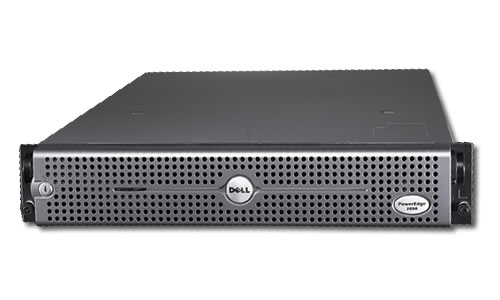
- (note: picture above not accurate)
Real picture:

Use: fileserver, database server, email server, host for all services that don't involve dynamic content provided by non-admins.
mire
- Location: Peer1
- Model: Sun Fire v20z
- Processor: 1 x 1.6GHz AMD64 (Opteron) (1/2)
- RAM: 5 GB (initial 2x512MB and additional 2x2GB, ? slots, 16 GB Max, DDR1/333 or DDR1/400 SDRAM)
- Disks (controller Ultra 320 SCSI):
- 2 x 36 GB (hot swap)
- CD-Rom
- Floppy
- LAN: 2 x 10/100/1000
- Form factor: 1U
- Ports: 1 x USB 1.1, 1 x DB9 serial, 2 x PCI-X
- Power: 100-240 V, 50/60 Hz, 465 W PFC supply, dual redundant fans
- Dimensions: W 16.94 in / H 1.69 in / D 28.5 in / Weight 35 lbs
- OS: Debian stable
- User logins: yes
- Source: donated by Ray Racine
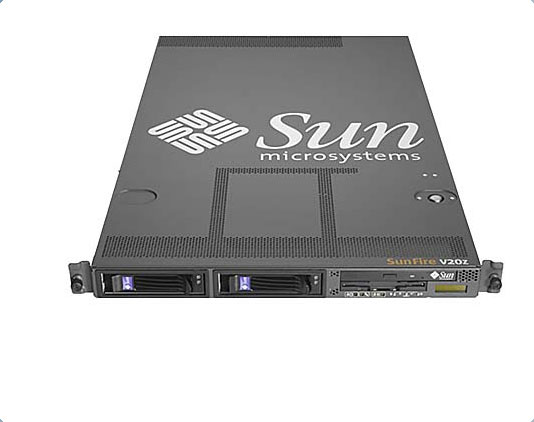


Real picture:

Use: dynamic web content, services that involve running arbitrary code from members (including custom daemons, etc.)
kvm
- Location: Peer1
Model: StarTech IP KVM
- Source: Newegg?
The StarTech Server Remote Control External KVM over IP provides access to systems that may have a degraded network. It allows us to monitor Power-On Self Test (POST), configure BIOS/CMOS, and even reinstall operating system software. It must be connected to another multiple port KVM in order to have access to more than one server.
Tech.coop
outpost
- Location: Tech.Coop (hosted at Bytemark, UK)
- Model: Xen VM
- Processor:
- RAM: 512 MB
- Disk: 40 GB RAID
- OS: Debian stable
- User logins: no
Use: secondary DNS on a different subnet, all tasks requiring remote location.
hopper
- Location: Peer1
- Model: IBM xSeries 335
- Processor: 2 x P4 XEON 2.6Ghz
- RAM: 4 GB, 2x1 GB, 1x2 GB (3/4 slots, 8 GB Max, PC2100 ECC registered)
- Disks:
- 2x SCSI Ultra 320 80 pin. SEAGATE - 5 YEARS MFG WARRANTY. CHEETAH 73.4GB 15000 RPM 80PIN ULTRA320 SCSI HARD DISK DRIVE. 16MB BUFFER 3.5 LOW PROFILE(1.0 INCH). ST373455LC
- Floppy 3.5"
- LAN: 2 x 10/100/1000
- Ports: 3 x USB, 1 x serial, 2 x PCI-X
- PSU: 1/1
- Form factor: 1U
- Dimensions: W 17.5 in / H 1.75 in / D 25.75 in / Weight 33 lbs
- OS:
- User logins: no
Name voting at https://members.hcoop.net/portal/poll?report=17
Source: US Ebay, seller lapkosoft. http://cgi.ebay.com/ws/eBayISAPI.dll?ViewItem&item=300200776299
Real picture:

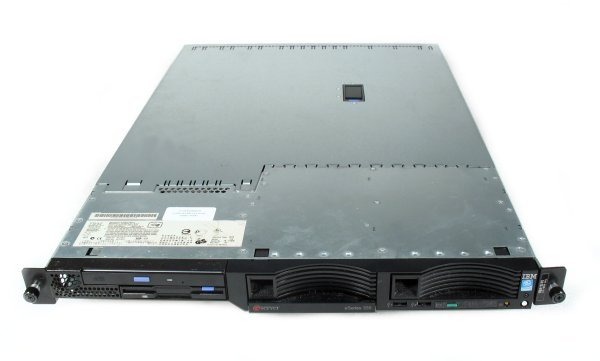
Back of hopper, taken 24feb09.jpg Hopper card closeup, taken 24feb09.jpg Inside hopper, taken 24feb09.jpg
Use: Initially, server was set up by Clinton Ebadi. It's purpose is to serve as a secondary KDC/AFS server instead of Krunk, and an email server (all email processing).
(The 1x2 GB RAM module was acquired from Newegg, and the two disks from ServerSupply. Purchases were made in Sep 2008, but ServerSupply took good 3 weeks to deliver).
Awaiting setup
None.
Awaiting purchase
None.
Decommissioned
abulafia: shell server
- Processor: 1 x 900 MHz
- RAM: 512 MB
- Disks: 40 GB RAID 1 (2 x 40 GB 7200 RPM ATA drives)
- Extra: 3Ware 6400 PCI ATA RAID controller
Intended use: refurbished slightly to serve as a generic shell server and the only machine where usage not strictly related to "Internet hosting" is permitted. Due to failing parts the machine was decomissioned completely and is no longer planned for reuse.
baltar
- Location: Peer1
- Nortel Baystack 380 switch
- Fabric: Dual 24-port Gigabit
- Memory: 16 MB SDRAM, 32 MB Flash
- Input current: 1.5A to 100 AC
- Input voltage (rms): 100 to 240 VAC at 47 to 63 Hz
- Power consumption: 150 W
- Thermal rating: 1000 BTU/hr maximum
- Dimensions: W 17.25 in / H 2.77 in / D 12.75 in / Weight 10.60 lbs
Source: donation by ShaunEmpie
http://support.nortel.com/go/main.jsp?cscat=DOCUMENTATION&poid=11941
214390a.pdf, 214391a.pdf, 214392a.pdf, 214393a.pdf, 214394a.pdf, 216339a.pdf
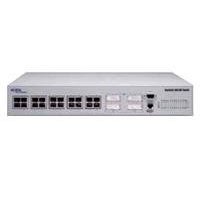
- Our switch "Baltar" was replaced by a smaller version in Dec 2008 to free up cabinet space, both for extra airflow and preparation to rack a new machine, to which all email processing will be moved.
xanadu
- Location: ???
Model: Dell PowerEdge 1650
- Processor: Dual P3 1.4GHz (2/2)
- RAM: 2 GB (?/4 slots, 4 GB Max, 72-bit ECC PC-133 SDRAM )
- Disks (controller Ultra 160 SCSI):
- 1 x 18 GB (1/3)
- Floppy 3.5"
- LAN: 2 x 10/100/1000
- Ports: 2 x PCI-X
- PSU: ?/2
- Power: 100–240 VAC, 50/60 Hz, 3.9–2.0 A, 275 W (AC) per PSU
- Form factor: 1U
- Dimensions: W 19 in / H 1.67 in / D 26.9 in / Weight 35 lbs
- OS:
- User logins:
Source: donation by NathanKennedy
http://support.dell.com/support/edocs/systems/pe1650/en/index.htm
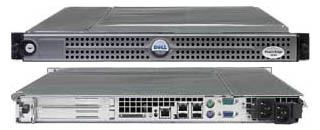
Use:
krunk
- Location: Peer1
- Model: Sun Netra
- Processor:
- RAM:
- Disks:
- 2 x 200GB Unknown RPM and Manufacturer
- Form factor: 1U?
- OS: Debian stable?
- User logins: no
- Source: donation by Adam Megacz
Real picture:

Use: was a secondary KDC and AFS server. Decomissioned after it developed problems in the hardware (as we perceived it) network stack.
